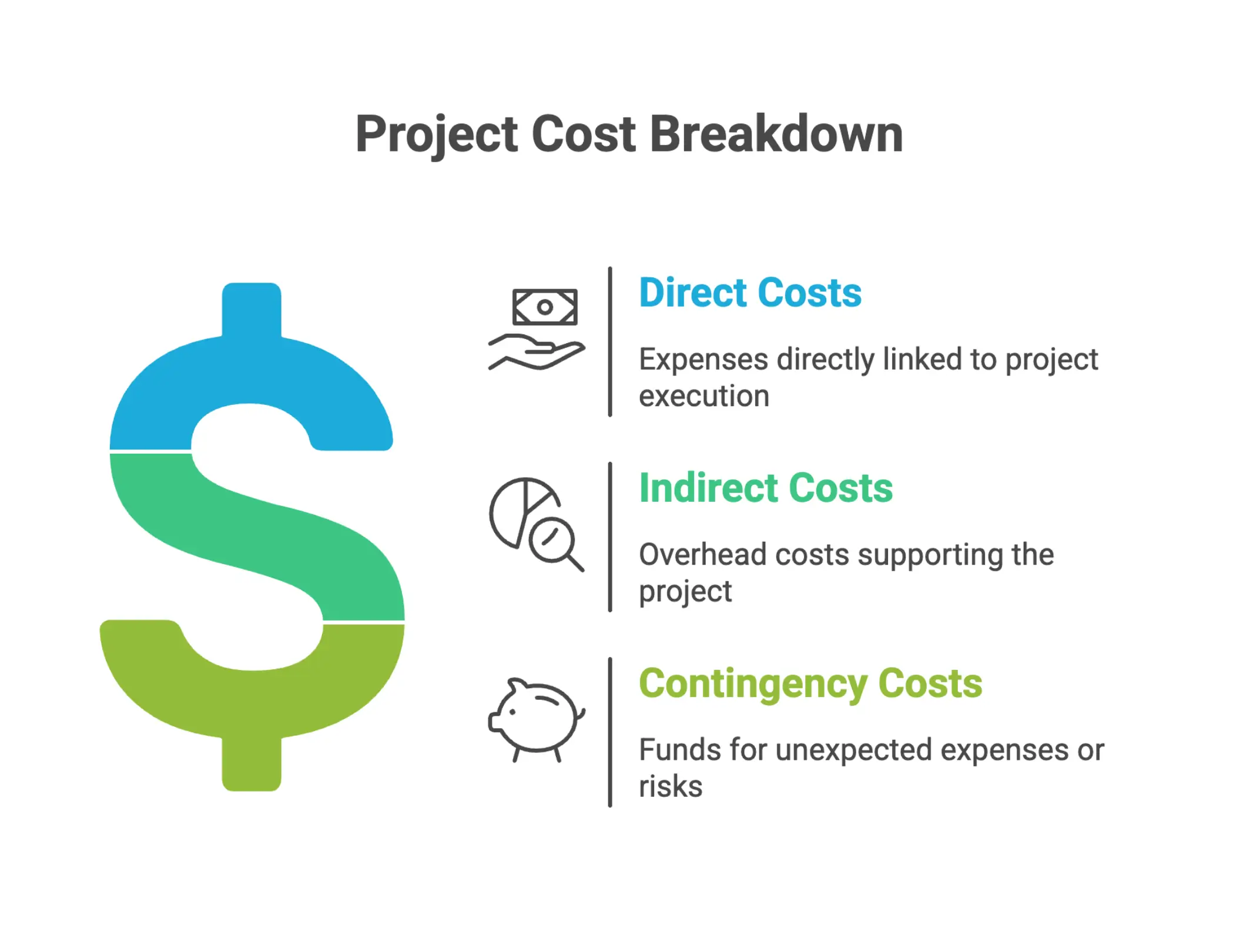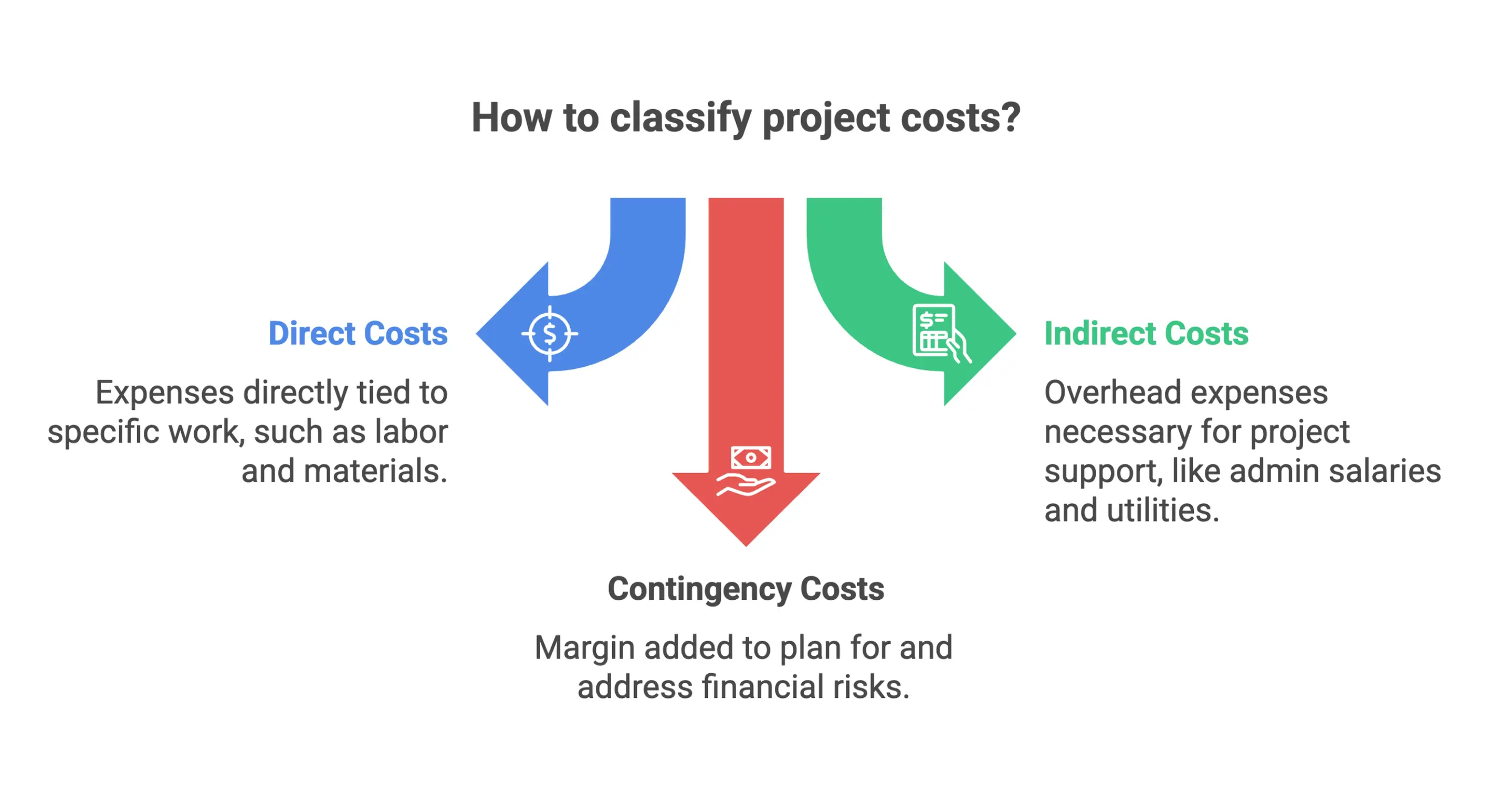
.webp)
What Is a Cost Breakdown Structure? A Complete Project Guide
TL;DR: A Cost Breakdown Structure (CBS) is a hierarchical framework for categorizing and organizing all project cost items. By ensuring every dollar, expense, and task has its place in the structure, a CBS delivers sharper budget visibility, improved cost tracking, and supports smarter project cost control. This article explores the basics of a cost breakdown structure, key cost categories, best practices, pitfalls, and digital tools that improve financial management.
What Is a Cost Breakdown Structure (CBS)?
A Cost Breakdown Structure (CBS) is a step-by-step hierarchical system for sorting and managing project costs. This framework provides project managers and stakeholders with a clear, structured view of project expenses. It becomes easier to align costs with the project scope and meet overall objectives. Every project cost, from labor and material costs to contingency and overhead costs, gets a place.
A well-crafted CBS empowers teams to track project expenses accurately, allocate resources efficiently through the project lifecycle, and prevent budget overruns or resource burnout. Its fundamental goal is to bring order to the often chaotic landscape of project costs, especially in construction projects or other industries with complex cost structures.
Why Use a Cost Breakdown Structure? Aligning Costs and Objectives
Ever feel like project costs vanish into confusing spreadsheets or email chains, blowing budgets out of the water? You’re not the only one. Disorganized or unclear project costs make it tough for project managers and stakeholders to manage spending and maintain financial control.
Increased competition and tighter timelines mean even minor mistakes in project cost estimation can have big repercussions. This is where a CBS shines. By providing a top-down breakdown of all the costs involved, teams gain transparency, control, and powerful tools for tracking and analyzing project spending.
Key takeaways:
- A CBS enables project managers to track expenses, monitor actual costs, identify cost drivers, and compare against estimates.
- It’s essential for proactive cost control, resource allocation, and risk management at every stage of the project.
- Integrating a CBS with a Work Breakdown Structure (WBS) offers a live overview of both costs and schedule, streamlining decision-making.
Cost Breakdown Structure Creating: The Basics
The process of creating a cost breakdown structure starts with clearly defining the project scope, then identifying key cost categories. From there, the CBS adds detailed subcategories for precise tracking, helping project managers and finance teams spot inefficiencies and forecast costs accurately.
A typical cost breakdown structure will include:
- Direct costs: Expenses directly linked to project execution, such as labor costs, equipment costs, and material costs.
- Indirect costs: Overhead costs that support the project but aren’t tied to a particular task, such as administration and safety.
- Contingency costs: Funds set aside to address unexpected expenses or risks during the project lifecycle.

By ensuring all the costs are organized in logical segments, a CBS also provides a reliable foundation for financial management, cost tracking, and thorough cost breakdown analysis.
Defining the Cost Breakdown Structure: An Organized Framework
Think of the CBS as your project’s financial blueprint. This hierarchical framework organizes every item of the budget into clear, manageable tasks and components. The structure allows project managers, finance staff, and the project team to see cost allocation from the highest level (overall project budget) down to the smallest detail.
This approach prevents cost drivers from slipping through the cracks and keeps resource allocation visible. Effective use of a CBS helps teams manage costs effectively, estimate all project-related costs, and maintain a clear audit trail of project spending.
Structure at a glance:
- Top level: Project or program
- Mid-levels: Key cost categories (e.g., labor, materials, equipment, overhead)
- Lowest level: Subcategories (e.g., raw materials, subcontractor labor, equipment rental)

For digital projects or construction industry applications, utilizing project management software and cost estimating tools streamlines CBS creation, monitoring, and updates.
Cost Breakdown Structure Example in Construction Projects
A CBS is especially critical for construction projects, where costs vary greatly and can spiral out of control quickly. Here’s a simplified example of a cost breakdown structure for a commercial build:
- Project level (entire project)
- Foundation (direct costs)
- Excavation (labor costs, material costs)
- Concrete (raw materials, equipment costs)
- Superstructure
- Framing
- Roofing
- Systems
- HVAC, electrical (equipment, labor)
- Indirect costs
- Site management, safety, insurance
- Contingency costs
- Budget for unforeseen expenses like bad weather or price increases
- Foundation (direct costs)
Each major cost category is broken into manageable components that match the project deliverables outlined in the Work Breakdown Structure (WBS). This side-by-side alignment ensures no element or associated costs are overlooked.
CBS and Key Cost Categories: Direct, Indirect, and Overhead Costs
Strong CBSs rely on organizing all costs into key cost categories. Understanding the difference helps with cost tracking and accurate financial management.
- Direct costs: These are expenses tied directly to specific work, such as labor costs for skilled workers, material costs for raw steel, or equipment costs for rental cranes.
- Indirect costs: These overhead costs are necessary for supporting the project, including admin salaries, utilities, and compliance requirements. Proper classifying of indirect costs avoids missing hidden costs and allows for a more accurate picture.
- Contingency costs: Adding a contingency margin at every project phase lets your team plan for and address financial risks.

A comprehensive CBS also covers labor costs, equipment costs, and other resource expenses in a centralized way, improving cost estimation and reducing the risk of budget overruns.
Integrating CBS with Work Breakdown Structure (WBS) for Full Cost Control
A Work Breakdown Structure (WBS) defines project deliverables and breaks work down into manageable tasks. The CBS, on the other hand, categorizes and organizes all project costs associated with these deliverables.
While the WBS answers “what needs to be done?” the CBS details “how much will each part cost?” Syncing the cost breakdown structure with the WBS creates a live map of costs and progress. Project managers can quickly compare estimated costs with actual costs incurred, adjust budgets, and track expenses at a granular level.
Quick facts:
- WBS is usually developed by the project team to map project deliverables and tasks
- CBS is typically developed by the finance or commercial department to map all the costs attached to those deliverables
- Using both together, especially in an integrated project management software, ensures real-time cost tracking and helps the team manage changes or risks throughout the project lifecycle
How a CBS Supports Project Cost Control and Cost Management
A CBS isn’t just paperwork. It’s a vital tool for ongoing cost management, risk mitigation, and clear communication. CBS offers these advantages for cost control:
- Accurate expense tracking: Enables project managers to compare estimated costs and actual costs at every stage.
- Better resource allocation: Identify inefficiencies and rebalance tasks or spending as work progresses.
- Forecasting and reporting: Maintain measurable cost controls, avoid budget overruns, and provide transparency for stakeholders.
- Risk management: Assign contingency costs, track financial risks, and maintain funds for uncertainty.
- Audit trail: Organized cost data simplifies project audits and reporting, supporting financial management and compliance.
Building a Strong Cost Breakdown Structure: Step-by-Step
1. Define Project Scope and Deliverables
Start with a detailed scope, listed in the Work Breakdown Structure. The CBS will mirror these components to map associated costs.
2. Identify Key Cost Categories
List direct costs (labor, equipment, raw materials), indirect costs (overhead expenses, safety, administration), and contingency costs. This ensures no costs are left out, and improves cost benchmarking.
3. Break Costs Down Into Manageable Components
Each cost category should be split into manageable tasks or line items, such as separating material costs into raw materials, prefabrication, and transportation for accuracy.
4. Assign Codes or Numbers
Use shared codes between the WBS and CBS for seamless tracking. This supports clean reporting and makes cost breakdown structure analysis easier during the project lifecycle.
5. Allocate Budget and Set Controls
Assign budget amounts and establish procedures for monitoring cost data, cost estimation, and cost forecasting.
6. Regularly Monitor and Update
Review the CBS throughout the project, updating actual costs incurred, and adjust the structure as the scope changes or unexpected expenses arise.

Creating a CBS: Tips for Success
- Involve both the finance or commercial department and the project team
- Adopt digital solutions for dynamic updating and detailed reporting
- Establish a regular process for cost breakdown analysis at key milestones
- Use lessons learned from similar past projects to refine categories and benchmarks
- Always include a contingency margin for risk management
Detailed Cost Segments: From Labor Costs to Equipment Costs
Breaking the CBS into detailed segments supports cost management for every project type. In commercial construction, for instance, you might create categories such as:
- Surveying and Site Prep: Includes all labor, equipment, and material costs for groundwork, such as land surveys, grading, and groundwork.
- Foundations and Substructure: Tracks all costs for excavation, core structural work, and materials.
- Systems Installation: Labor costs, equipment costs, and material costs for HVAC, electrical, and plumbing systems.
- Finishes and Fit-Out: Material and labor costs for interior build, external landscaping, and specialized work.
For each category, the CBS should reference all associated costs including direct and indirect costs and allocate funds for contingency costs.
Resource Breakdown Structure: The Missing Link
The resource breakdown structure (RBS) defines all the resources required for a project, such as people, equipment, and materials. While the CBS tracks costs, the RBS clarifies where those resources come from and how they are allocated.
Together, the WBS, CBS, and RBS form a full toolkit for managing costs, estimating accurately, and preventing overspend. Aligning these structures means you gain both cost visibility and resource allocation insight.
How CBS Improves Stakeholder Alignment
A CBS brings clarity and alignment among all project stakeholders. Stakeholders can review cost allocation, question project managers about project expenses, and contribute to informed decisions quickly.
Benefits for different groups:
- Project managers: Track expenses, adjust spending, and make informed decisions in real time
- Clients and finance teams: View budget allocations for each deliverable or milestone
- Engineers and execution teams: Understand cost drivers behind their assigned work
Using a CBS ensures everyone works from the same set of cost data and cost breakdowns, avoiding misunderstanding and supporting collaboration.
Common Pitfalls in Cost Breakdown Structure Creation
1. Omitting Direct and Indirect Costs
Neglecting to include hidden costs, indirect costs, or overhead costs can lead to surprise overruns. It’s vital to document every project cost, from site management to insurance and permits, in the cost breakdown structure for accuracy.
2. Poor Integration With Work Breakdown Structure
If the CBS and WBS aren’t aligned, cost tracking becomes guesswork. Use common codes, keep structures side by side, and choose project management software that enables seamless integration.
3. Not Including a Contingency Margin
Leaving out contingency costs sets up the project for trouble. Allocate funds for risk and adjust as actual costs occur throughout the project lifecycle.
4. Failing to Update Regularly
Don’t treat the CBS as static. Projects evolve, and so do costs. Update the CBS as actual costs are incurred, and monitor cost breakdowns at every phase.
5. Incomplete Resource Allocation
Without mapping every resource, such as labor, equipment, and materials, to costs, waste and overspending creep in. Use the resource breakdown structure alongside your CBS and WBS.

Cost Breakdown Analysis: A Strategic Tool
Cost breakdown analysis digs into every cost element to uncover areas where savings are possible and where costs have drifted from estimates. By analyzing actual costs versus plan, project managers can refine future cost estimation, inform pricing strategies, and target cost efficiency.
Benefits of regular cost breakdown analysis:
- Identifies cost drivers and areas for improvement
- Ensures all the costs are tracked and justified
- Adds transparency and accountability
- Provides financial discipline across the project lifecycle
A robust cost breakdown structure makes this analysis seamless, especially when merged with digital project management tools.
CBS in Action: Digital Tools for Enhanced Cost Control
Modern cost estimating software such as CostOS streamlines CBS creation, integration with WBS, and real-time cost tracking. Digital tools help automate reports, keep actual costs synced with estimates, and simplify audits.
Connecting enterprise estimating suites, ERP systems, and project management software gives the project team live, centralized access to all cost data for smarter, faster decisions.
Frequently Asked Questions About Cost Breakdown Structures
What is a Cost Breakdown Structure (CBS)?
A Cost Breakdown Structure (CBS) is a hierarchical framework that categorizes and organizes all project cost items. The CBS provides a structured view of project expenses, helping to align costs with project scope and objectives and ensuring accurate tracking and financial control.
How does CBS differ from Work Breakdown Structure (WBS)?
A CBS organizes and tracks costs for each project part, while a WBS defines the project deliverables and tasks required for completion. Both are essential structures for effective project management and work best when integrated.
Why is a CBS critical for construction projects?
Construction projects involve complex and varied project costs. Using a CBS ensures every dollar spent, from labor costs to equipment costs, is tracked and managed. This prevents budget overruns, identifies inefficiencies in resource allocation, and supports cost control.
What are indirect costs, and how do they differ from direct costs?
Direct costs are expenses directly linked to specific project tasks, such as materials or hourly wages for crew. Indirect costs (or overhead costs) include administrative expenses and site-wide services supporting the project but not tied to a single task.
How can digital tools help improve CBS accuracy?
Digital tools, like CostOS cost estimating software, construction management systems, and integrated ERP, allow real-time updates, seamless linking of CBS and WBS, and automatic reporting. This supports improved cost control and financial management.
What is cost breakdown analysis, and why is it important?
Cost breakdown analysis identifies and analyzes all project cost drivers to optimize spending, improve cost estimation, and increase profitability. Regular analysis ensures spending stays aligned with the budget and uncovers cost-saving opportunities during the project lifecycle.
How do overhead costs impact a project’s budget?
Overhead costs are ongoing, business-supporting expenses. Failing to include them in the CBS can reduce accuracy and risk budget overruns. Track overhead expenses within the indirect costs section.
Is it necessary to include contingency costs in every CBS?
Yes, including contingency costs helps prepare for unplanned events, financial risks, or scope changes. This minimizes surprises and supports a successful project outcome.
Who should create and maintain the CBS?
While the finance or commercial department typically crafts the CBS, input from the project team is critical for complete coverage. Continual collaboration ensures all project expenses are captured.
What’s an example of improved cost control using CBS?
Aligning the CBS with the resource breakdown structure and project management software allows project managers to track expenses in real time and make data-driven decisions. This delivers projects on budget and schedule.
Summary: Smarter Project Cost Control With CBS
A Cost Breakdown Structure represents a straightforward but powerful tool for project managers and teams to identify costs, allocate resources, and control project budgets. By organizing all costs into clear categories and detailed components, the CBS supports successful project execution, informed decisions, transparency among stakeholders, and financial discipline from beginning to end.
Regular use of a CBS, especially in conjunction with WBS and resource allocation structures, ensures project teams can manage all the costs, optimize resource distribution, and prevent unexpected expenses.
Ready to modernize your cost control strategy? Explore Nomitech’s product suite or contact us to find the CBS software that fits your next project’s needs. Manage project costs, enhance forecasting, and build confidently with the right tools and frameworks in place.




